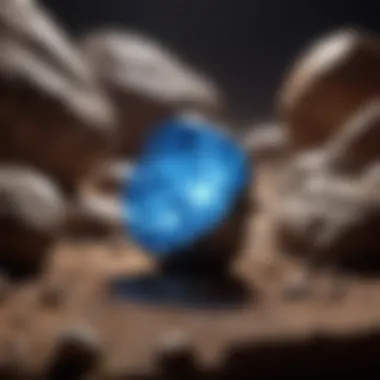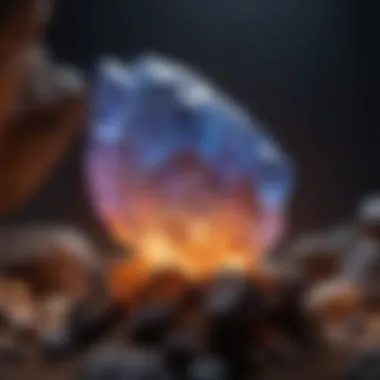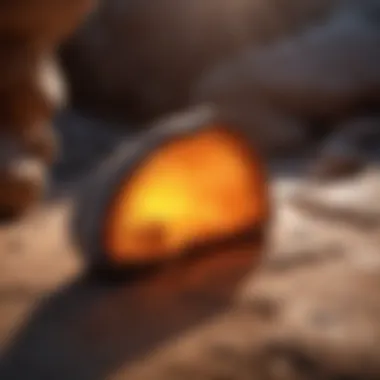Choosing the Best UV Light for Rock Collectors


Intro
For anyone vested in the colorful world of geological treasures, identifying and showcasing rocks and fossils is not just a hobby; it's a passion. An essential tool in this pursuit is the ultraviolet (UV) light. Selecting the right UV light can elevate your enjoyment and understanding of your collection, allowing you to see your specimens in a completely new light—both figuratively and literally.
Choosing the ideal UV light involves more than just picking a bright beam. It's about recognizing the specific needs tied to the types of rocks or fossils you collect. Different specimens react uniquely under UV rays, revealing a range of fluorescence that might go unnoticed in standard lighting. This article aims to unpack the intricacies of selecting a UV light suited for collectors, focusing on vital aspects such as specifications, safety measures, and practical applications.
Whether you're a budding enthusiast or a seasoned contributor to geological forums, having a clear understanding of these factors is paramount. In this guide, we will explore not only the technical specifications but also the historical context of rock and fossil collection, ensuring you are equipped with the essential insights for making informed choices.
Understanding Ultraviolet Light
In the realm of geology, understanding ultraviolet (UV) light stretches beyond mere curiosity; it acts as a pivotal tool for hobbyists and professionals alike. Whether one is examining intriguing mineral specimens or searching for secrets hidden within rocks, a solid grasp of UV light's characteristics can substantially enhance one's pursuits. Recognizing the nuances of how UV light operates and its applications within geology can lead to more fruitful grass-roots discoveries and a hands-on appreciation of nature's treasures.
Definition and Classification of UV Light
Ultraviolet light, as a part of the electromagnetic spectrum, has wavelengths shorter than visible light but longer than X-rays. Specifically, it ranges from about 10 nm to 400 nm. UV light is subdivided into three primary classifications:
- UV-A (315-400 nm): This type is the least energetic and is widely recognized for its role in causing skin tanning, as well as initiating certain fluorescence in minerals.
- UV-B (280-315 nm): Known for its more intense effects, UV-B light largely contributes to the sunburn and can also influence mineral interactions, though its presence in natural sunlight is considerably lower than UV-A.
- UV-C (100-280 nm): This is the most energetic type of UV light but is largely absorbed by the Earth’s atmosphere, thus seldom reaching the ground. This classification is crucial for laboratory settings where sterilization and specific mineral experiments might take place.
It's fascinating to note how different minerals react uniquely to varying wavelengths of UV light. For instance, while certain fluorites might glow a brilliant blue under UV-A but remain dull under UV-C, others might burst into vivid greens or oranges, highlighting the beauty trapped within each specimen.
The Role of UV Light in Geology
The application of UV light in geology indeed turns the old adage about seeing the world through different lenses into a reality. Geologists utilize UV light for a variety of practical purposes:
- Fluorescence observation: Many minerals exhibit fluorescence, appearing to shine under UV light. This quality can be helpful in identifying specific rock types, particularly when distinguishing between them.
- Authenticity checks: In the world of mineral collection, UV light helps collectors authenticate specimens such as fluorite or scheelite, which exhibit notable differences under UV illumination, providing insights that aren't visible under regular light.
- Education: Understanding how minerals fluoresce can serve as a significant educational tool, illustrating how light interacts with matter and revealing the complex chemistry of geological formations.
It's no secret that many rocks have their own stories to tell, hidden just beneath the surface. By harnessing the power of UV light, collectors can unlock these narratives, revealing a vibrant world of colors and characteristics otherwise overlooked. This increased understanding not only enriches an individual's collection but also deepens the appreciation for the intricate processes that shape our planet.
Types of UV Lights
Choosing the right type of UV light is crucial for rock enthusiasts and collectors. The right UV light can enhance the beauty of the specimens, revealing unique characteristics that are otherwise hidden. In this section, we will delve into the different types of UV lights, examining their specific elements, benefits, and considerations.
UV-A, UV-B, and UV-C: Understanding the Differences
When talking about UV light, not all types are created equal. The three main categories—UV-A, UV-B, and UV-C—each possess unique wavelengths and applications.
- UV-A ranges from 320 to 400 nanometers and is the most common type used for rock inspection. It is gentle on most materials, allowing collectors to observe fluorescence without damaging the rocks. Furthermore, specific minerals like willemite and sodalite glow brilliantly under UV-A light, showcasing colors that are simply captivating.
- UV-B has a shorter wavelength, from 280 to 320 nanometers. While it is effective in stimulating fluorescence, UV-B can be more harmful. Prolonged exposure might cause damage to both the specimens and the viewer, so caution is advised when using this type in rock examination.
- UV-C possesses the shortest wavelengths, roughly 100 to 280 nanometers. This type is primarily used for sterilization and is not typically appropriate for examining rocks. It can cause significant damage, so it generally sits on the sideline in discussions among collectors.
A clear understanding of how these UV types differ will guide collectors in selecting the right light for their needs.
LED vs. Traditional UV Bulbs
In the rapidly evolving world of UV lighting, choosing between LED and traditional bulbs can be a tricky affair. Each has its merits and drawbacks that are worth considering.
- LED UV Lights
- Traditional UV Bulbs
- Energy Efficient: They use less power and last longer, reducing the need for frequent replacements.
- Low Heat Emission: This is particularly beneficial for sensitive specimens that could be affected by high temperatures.
- Immediate Activation: Unlike traditional bulbs, which might take a while to reach their full brightness, LEDs illuminate instantly, making them convenient for quick examinations.
- Brightness: Traditional bulbs may produce a wider spectrum of UV light, providing a more robust examination, crucial for discerning subtle features in certain rocks.
- Cost: Often cheaper to purchase upfront, traditional systems might appeal to those with budget concerns.
- Wavelength Variation: Some traditional bulbs allow for adjustments in wavelength, which can be advantageous in specific geological evaluations.


In essence, the choice between LED and traditional UV lights hinges on personal preference and specific use cases in rock examination.
Handheld vs. Stationary Units
Consider the purpose and location of use when deciding between handheld and stationary UV units. Each serves different needs within the rock collecting community.
- Handheld Units
- Stationary Units
- Portability: Perfect for fieldwork, allowing collectors to illuminate specimens wherever they may roam.
- Flexibility: Handheld lights can be directed precisely where needed, uncovering hidden features in hard-to-reach spots.
- Ease of Use: Generally user-friendly; just point and click without the hassle of setup.
- Stability: Ideal for detailed examinations in a controlled environment, ensuring no shaking or movement interferes with observations.
- Broader Application: Often designed for more extensive setups, they can cater to larger collections or educational settings.
- Higher Intensity: Stationary units may provide stronger light output, essential for revealing intricate geological details.
Ultimately, the decision between handheld and stationary units should align not only with the individual's specific rock collector’s activities but also with their broader objectives.
Criteria for Selecting a UV Light
When it comes to picking out the right UV light for examining rocks, there's more at stake than a simple "which one looks good." The criteria for choosing a UV light impact how effectively you can observe, analyze, and enhance the beauty of your specimens. Every rock collector, whether a casual hobbyist or a seasoned expert, should keep these elements in mind: wavelength, intensity, and portability. By focusing on these specifics, you can make an informed decision that aligns with your interests and needs.
Wavelength Considerations
Wavelength plays a crucial role in the effectiveness of UV lights. Different wavelengths can illuminate various properties in minerals and fossils. For instance, UV light comes in three main categories: UV-A, UV-B, and UV-C, each with distinct capabilities and applications.
- UV-A (315-400 nm) is prevalent for examining a wide spectrum of fluorescent gems and minerals, such as calcite and fluorite.
- UV-B (280-315 nm) can induce fluorescence in some materials but is less commonly used due to its potential for skin damage.
- UV-C (100-280 nm) is primarily for sterilization and not suitable for rock analysis.
Understanding the right wavelength for your specific stones is vital. If you're particularly interested in fluorescence, UV-A is the way to go. Collectors should research the properties of their specimen types to enhance their analysis and collection display effectively.
Intensity and Output
Intensity refers to how much light is emitted from the source, while output is a combination of that intensity and the effectiveness of the wavelength used. Essentially, having a high-intensity UV light can make the difference between seeing subtle fluorescence versus missing out on those wow moments.
- Consider the following points when assessing intensity and output:
- Not all rocks fluoresce equally; some may require level of intensity to show their colors.
- A light that boasts higher output won't always mean better visibility. It's essential to balance intensity with quality.
- Look for UV lights offering adjustable intensity settings, allowing you to customize how much light you’re throwing at the rock, which can help showcase the desired aspects without overwhelming the observation.
Portability and Durability
For any rock enthusiast, the ability to take your UV light on the go can be a game changer. Portability often means features like lightweight construction and compact design, while durability speaks to how well that light can withstand the inevitable bumps and bruises associated with outdoor exploration.
- When considering portability and durability, think about:
- If you plan to use the UV light in the field, opt for a robust, water-resistant model. There are handheld versions that are sturdy enough for rugged terrains, yet remain portable for easy transport.
- Battery life is essential; you don’t want to find yourself stuck in the middle of nowhere with a dead light. Look for a product with long-lasting battery options or easy recharging capabilities.
- Weigh whether you need something lightweight for hikes or a heavier model for display purposes.
"In the world of geology, the right tools can transform your understanding of what lies beneath the surface. Picking the ideal UV light is no different. "
Ultimately, taking the time to evaluate each of these criteria will greatly enhance your experience as a collector. It's not about picking the first light you see; it’s about choosing one with the right wavelength, optimal intensity, and sufficient durability to suit your specific collecting needs.
Knowing these aspects allows rock enthusiasts to climb the learning curve faster and enjoy the nuances that each specimen offers.
Best Practices for Using UV Light
When it comes to using ultraviolet light effectively, particularly for rock enthusiasts and collectors, having a clear grasp on best practices is key. Understanding how to utilize these powerful tools not only enhances the examination of your geological specimens but also ensures you do it safely. This section will elaborate on vital safety precautions and techniques that can maximize the benefits of your UV light.


Safety Precautions
Eye Protection
Eye protection is non-negotiable when working with UV light. Prolonged or unintentional exposure can lead to a host of problems, including photokeratitis, often likened to sunburn of the cornea. One prominent option for safeguarding your eyes is UV-blocking goggles. These specialized eyewear can filter out harmful rays, allowing you to enjoy the observation of your rock collection without putting your vision at risk.
In addition to filtering UV rays, a good pair of protective goggles should also offer a snug fit to prevent side exposure. Finding a comfortable pair is not just about safety; it should also be part of a productive observation experience. They are a popular choice in the rock-collecting community mainly because they are both affordable and effective. The unique feature of these goggles is that they often come with anti-fog coatings, which is a game changer when you're examining rocks under varying temperatures. Whether out in the field or in a cozy indoor setting, clear visibility should be a priority.
Skin Safety
Skin safety is just as crucial as protecting your eyes. The skin can be quite sensitive to ultraviolet radiation, leading to severe burns, or in some cases, longer-term complications such as skin cancer. To address this, it's wise to apply broad-spectrum sunscreen with a high SPF on exposed skin areas before engaging in UV activities. This particular type of sunscreen is recommended as it provides more extensive protection.
A unique aspect of skin safety is that many rock enthusiasts often overlook how reflective surfaces like quartz or even water can intensify UV rays. This means putting on protective clothing may also be beneficial, particularly if you'll be in the field for extended periods. Wearing loose-fitting, long-sleeve shirts can minimize exposure while allowing you to remain comfortable on warm days. In terms of advantages, proper sun protection can greatly enhance your enjoyment of rock observation, ensuring that you focus on the experience rather than potential discomfort from sun exposure.
Enhancing Obsidian and Fluorescent Rock Observation
Using UV light can dramatically alter the appearance of certain minerals, particularly obsidian and fluorescent rocks. These types of specimens often reveal vibrant, hidden colors and patterns when exposed to ultraviolet lighting.
When observing obsidian, a quick wave of UV light can show intricate designs not immediately visible. This phenomenon can enhance your understanding of texture and structure, allowing for a more thorough analysis of the specimen.
For fluorescent rocks, the experience of using UV light is almost magical. They can fluoresce in hues that are entirely unexpected under normal light. Investing time in learning the specific wavelengths that enhance the glow of your fluorescent minerals can yield fruitful results. A few pointers:
- Use a UV light that allows for various wavelengths, particularly UV-A and UV-B.
- Hold the light at different angles to catch the best glow.
"Every rock tells a story, and with the right UV light, you can illuminate chapters previously shrouded in darkness."
Determining the right lighting can mean the difference between a mediocre session and a breathtaking revelation in your rock collection. Whether you are a seasoned collector or just starting, understanding how to enhance your observations with UV light will undoubtedly elevate your collecting experience.
Top UV Lights for Rock Collectors
Choosing the right UV light is not just a luxury for rock collectors; it’s a necessity. The perfect UV light can mean the difference between mundane rock observation and a transformative experience where every speck of mineral can shine in its full luminescent glory. Whether you're an amateur or well-versed in geology, having the right tool enhances your ability to explore rock specimens, revealing hidden attributes that can only be seen under UV light. The variance in quality and types of UV lights available on the market can be quite daunting, but knowing what’s out there can help you steer towards the right options that fit your needs.
Acclaimed Brands and Models
When diving into the pool of UV lights designed for enthusiasts, certain brands stand out like diamonds in the rough. Not only do they offer quality specs, but they have also earned the trust of the collecting community.
- Black Light World: Renowned for their reliability, they provide various models that cater to both casual users and serious collectors. Their products often boast durability and high-intensity options suitable for extensive fieldwork.
- Streamlight: Known for their LED technology, Streamlight’s UV flashlights offer portability without sacrificing performance. They’re easy to carry during hikes or exhibitions.
- SpectraLight: Catering to professionals, their UV lamps are designed to deliver consistent performance in laboratory settings, making them ideal for serious collectors seeking precision.
It's prudent to read reviews and collect opinions from other rock enthusiasts; they span all the pros and cons of various models.
Comparative Analysis of Features
When it comes to selecting the right UV light, examining features is like comparing apples to oranges—many unique aspects can influence your decision.
Price Factors
The price of UV lights can vary significantly; understanding why certain models cost more is essential. Higher prices often correlate with better quality components and advanced technology. For instance, UV lights with a longer wavelength range usually fall on the higher end of the pricing spectrum. This is because they are capable of revealing a wider variety of fluorescent minerals, a critical aspect for rock collectors interested in unique specimens. However, this doesn’t mean that mid-range options don’t offer value. Many collectors report satisfactory experiences with budget-friendly alternatives, but you must weigh what you need against what you’re spending.
- Key characteristics of price factors include:
- Reliability: Higher-priced models generally have a better lifespan.
- Versatility: Expensive lights often provide features for multiple uses, not just rock collection.


The downside might be, of course, feeling the pinch on your wallet. But remember the old saying: "You get what you pay for."
Warranty and Support
Warranty and support is another critical factor that shouldn't be overlooked. Typically, well-established brands offer robust warranties as they are confident in their product's longevity. For rock collectors, having that peace of mind is invaluable, especially if you plan on using your UV light extensively.
- Many reputable brands provide warranty services ranging from one year to a lifetime guarantee. This kind of support signifies that the manufacturer stands behind their product.
- The unique feature of good warranty could mean a replacement for defects that would otherwise derail your collecting journey.
Collecting rocks should be a passion, not a hassle. Being covered by a solid warranty can make all the difference, allowing you to focus more on exploration rather than equipment issues.
"Investing in the right UV light, supported with a solid warranty, fosters a confidence that lets you dive deep into your passion for geology without worrying about your equipment."
Maintenance and Care for UV Lights
Proper maintenance and care of UV lights is vital for rock enthusiasts and collectors who rely on these tools for observation and classification. Taking good care of your UV light not only prolongs its lifespan but also ensures that it performs at its best. A well-maintained device provides consistent, reliable results, which is essential when examining unique geological specimens.
Regular upkeep reduces the risk of costly repairs down the line. It's like a car; if you don’t change the oil or rotate the tires, it’s bound to break down when you least expect it. By understanding the nuances of cleaning, storage, and component longevity, collectors can maximize the utility of their UV lights over time.
Cleaning and Storage Recommendations
When it comes to cleaning your UV light, avoid using harsh chemicals that might damage the casing or the lens. Instead, a soft, lint-free cloth lightly moistened with water works wonders. Gentle cleaning not only keeps your equipment looking sharp but also prevents dirt and dust from interfering with the intensity of the light. Always clean the lenses after use—this is akin to putting your glasses away dirt-free for the next time.
After cleaning, proper storage is equally important. Consider storing your UV lamp in a protective case, which shields it from dust, moisture, and accidental drops. The ideal location is a cool, dry place, away from direct sunlight, where fluctuations in temperature are minimal. If you let it sit in a damp garage, that’s a sure-fire way to doom your investment. Remember to keep it away from prolonged exposure to heat—high temperatures can degrade the integrity of the bulb and internal components over time.
Replacement and Lifecycle Expectations
Understanding the lifecycle of your UV light is essential to ensure uninterrupted usage. Most UV lamps come with a specific lifespan, typically measured in hours of operation. For instance, traditional fluorescent UV bulbs usually last around 1,000 hours, while LED options can run much longer—up to 25,000 hours before needing a replacement.
Monitoring the output intensity after extensive use is a best practice. If you notice the light seems dimmer than usual, it’s time to consider changing the bulb. Not doing so can affect your ability to see fluorescent qualities in rocks, making your collecting efforts less effective.
Lastly, always familiarize yourself with the warranty and customer support options available for your product. If a defect arises early on, you want the reassurance that the manufacturer will step in. Don’t wait until the last minute; proactive measures, such as keeping the receipt and documentation, can save a world of trouble.
"A well-taken care of UV light is not just a tool; it’s an investment in your passion for collecting."
Future Trends in UV Lighting for Geology
The world of geology is constantly evolving, and so is the technology that supports it. As rock enthusiasts and collectors dive deeper into their passion, they must stay informed about the latest advancements in UV lighting. This section discusses some key trends that are set to revolutionize how collectors examine and showcase their precious specimens, emphasizing new technologies and the importance of adaptability in this ever-changing field.
Innovative Technologies on the Horizon
The acceleration of technological innovation is reshaping UV light applications in geology. Several noteworthy developments stand out:
- Smart UV Lighting: Lux sensors and mobile app integration allow users to monitor UV light intensity and wavelength in real-time. It's akin to having a digital companion that ensures you're using the right settings for optimal rock examination.
- Compact and Portable Designs: New models are emerging that are not only lightweight but also feature multi-wavelength capabilities. This means collectors can carry versatile tools in their backpacks, ready to use whenever the opportunity arises.
- Environmental Sustainability: Innovations are frequently focusing on energy-efficient LEDs, reducing power consumption significantly. This trend caters to the growing demand for eco-friendly practices among collectors who value sustainability just as much as their artifacts.
In summary, these examples showcase how the integration of technology is enhancing user experience while maintaining a focus on efficiency and environmental impact.
Implications for Rock Collectors
As these innovative technologies become more accessible, rock collectors can look forward to several benefits:
- Enhanced Observation: The precise wavelength control offered by smart UV lights allows for more detailed examination of minerals and fossils. This, in turn, can lead to better identification and appreciation of specimens in a collector's arsenal.
- Educational Opportunities: With tech-savvy lights come educational prospects. Collectors can experiment with different settings and wavelengths, expanding their understanding of geology and related sciences.
- Community Engagement: As peer-to-peer shared experiences rise, embracing these new technologies can bring collectors together. Community platforms, like reddit.com/r/rockhounding, showcase collections illuminated by innovative lighting, creating a space for exchange and inspiration.
- Increased Safety: Modern UV lights are integrating safety features that minimize harmful exposure. This means collectors can admire their rocks with greater peace of mind.
As the landscape of UV lighting continues to develop, rock collectors who embrace these advancements will find themselves not just as hobbyists, but as pioneers in the exploration of geology. Staying ahead of the curve is not only advisable; it is essential for anyone serious about their collection.
"Innovation is the key to progress."
In this spirit, by keeping an eye on future trends, rock enthusiasts can make informed choices that elevate their passion and ensure they are equipped with the best tools available.



